
History of the Gambia
Encyclopedia
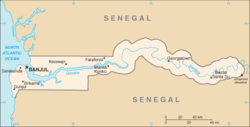
The Gambia
The Republic of The Gambia, commonly referred to as The Gambia, or Gambia , is a country in West Africa. Gambia is the smallest country on mainland Africa, surrounded by Senegal except for a short coastline on the Atlantic Ocean in the west....
was once part of the Ghana, Mali
Mali Empire
The Mali Empire or Mandingo Empire or Manden Kurufa was a West African empire of the Mandinka from c. 1230 to c. 1600. The empire was founded by Sundiata Keita and became renowned for the wealth of its rulers, especially Mansa Musa I...
and Songhai Empire
Songhai Empire
The Songhai Empire, also known as the Songhay Empire, was a state located in western Africa. From the early 15th to the late 16th century, Songhai was one of the largest Islamic empires in history. This empire bore the same name as its leading ethnic group, the Songhai. Its capital was the city...
s.
Early history
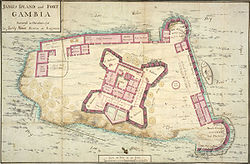
Arab
Arab people, also known as Arabs , are a panethnicity primarily living in the Arab world, which is located in Western Asia and North Africa. They are identified as such on one or more of genealogical, linguistic, or cultural grounds, with tribal affiliations, and intra-tribal relationships playing...
traders in the 9th and 10th centuries AD. In medieval times the area was dominated by the trans-Saharan trade
Trans-Saharan trade
Trans-Saharan trade requires travel across the Sahara to reach sub-Saharan Africa. While existing from prehistoric times, the peak of trade extended from the 8th century until the late 16th century.- Increasing desertification and economic incentive :...
. The reign of the Mali Empire
Mali Empire
The Mali Empire or Mandingo Empire or Manden Kurufa was a West African empire of the Mandinka from c. 1230 to c. 1600. The empire was founded by Sundiata Keita and became renowned for the wealth of its rulers, especially Mansa Musa I...
, most renowned for the Mandinka
Mandinka people
The Mandinka, Malinke are one of the largest ethnic groups in West Africa with an estimated population of eleven million ....
ruler Mansa
Mansa
Mansa is a Mandinka word meaning "king of kings". It is particularly associated with the Keita Dynasty of the Mali Empire, which dominated West Africa from the thirteenth to the fifthteenth century...
Kankan Musa, brought world wide recognition to the region due to its enormous wealth, scholarship, and civility. The North African scholar and traveler Ibn Battuta
Ibn Battuta
Abu Abdullah Muhammad Ibn Battuta , or simply Ibn Battuta, also known as Shams ad–Din , was a Muslim Moroccan Berber explorer, known for his extensive travels published in the Rihla...
visited the area in 1352 AD and said this about its inhabitants:
Since the early 13th century, the Kouroukan Fouga
Kouroukan Fouga
The Kouroukan Fouga or Kurukan Fuga is purported to be the constitution of the Mali Empire , created after the Battle of Krina by an assembly of notables to create a government for the newly established empire. It was first alluded to in print in Djibril Tamsir Niane's book, Soundjata, ou la...
, Mali
Mali
Mali , officially the Republic of Mali , is a landlocked country in Western Africa. Mali borders Algeria on the north, Niger on the east, Burkina Faso and the Côte d'Ivoire on the south, Guinea on the south-west, and Senegal and Mauritania on the west. Its size is just over 1,240,000 km² with...
's constitution, was the law of the land. The Songhai Empire
Songhai Empire
The Songhai Empire, also known as the Songhay Empire, was a state located in western Africa. From the early 15th to the late 16th century, Songhai was one of the largest Islamic empires in history. This empire bore the same name as its leading ethnic group, the Songhai. Its capital was the city...
, named after the Soninke people whose king assumed official control of the Empire, came to dominate the region in the 16th century. As time went on the area began to suffer from continuous Moroccan
Morocco
Morocco , officially the Kingdom of Morocco , is a country located in North Africa. It has a population of more than 32 million and an area of 710,850 km², and also primarily administers the disputed region of the Western Sahara...
and Portuguese
Portugal
Portugal , officially the Portuguese Republic is a country situated in southwestern Europe on the Iberian Peninsula. Portugal is the westernmost country of Europe, and is bordered by the Atlantic Ocean to the West and South and by Spain to the North and East. The Atlantic archipelagos of the...
invasion and looting. By the end of the 16th century, as the raids continued, the empire collapsed and was conquered and claimed by Portugal
Portugal
Portugal , officially the Portuguese Republic is a country situated in southwestern Europe on the Iberian Peninsula. Portugal is the westernmost country of Europe, and is bordered by the Atlantic Ocean to the West and South and by Spain to the North and East. The Atlantic archipelagos of the...
.
In 1588, the claimant to the Portuguese throne, Antonio, Prior of Crato
António, Prior of Crato
António, Prior of Crato , was a grandson of King Manuel I of Portugal, claimant of the Portuguese throne during the 1580 dynastic crisis, who was King of Portugal as António I of Portugal during 33 days in the continent in 1580, and, after the crowning of Philip II of Spain as King of Portugal,...
, sold exclusive trade rights on The Gambia River to English merchants; this grant was confirmed by letters patent from Queen Elizabeth I. In 1618, King James I
James I of England
James VI and I was King of Scots as James VI from 24 July 1567 and King of England and Ireland as James I from the union of the English and Scottish crowns on 24 March 1603...
granted a charter to an English company for trade with The Gambia and the Gold Coast
Gold Coast (British colony)
The Gold Coast was a British colony on the Gulf of Guinea in west Africa that became the independent nation of Ghana in 1957.-Overview:The first Europeans to arrive at the coast were the Portuguese in 1471. They encountered a variety of African kingdoms, some of which controlled substantial...
(now Ghana). Between 1651 and 1661 part of Gambia was (indirectly) a colony of Polish-Lithuanian Commonwealth
Polish-Lithuanian Commonwealth
The Polish–Lithuanian Commonwealth was a dualistic state of Poland and Lithuania ruled by a common monarch. It was the largest and one of the most populous countries of 16th- and 17th‑century Europe with some and a multi-ethnic population of 11 million at its peak in the early 17th century...
; it was purchased by the Courlandish duke Jakub Kettler. At that time Courland
Courland
Courland is one of the historical and cultural regions of Latvia. The regions of Semigallia and Selonia are sometimes considered as part of Courland.- Geography and climate :...
, in modern-day Latvia
Latvia
Latvia , officially the Republic of Latvia , is a country in the Baltic region of Northern Europe. It is bordered to the north by Estonia , to the south by Lithuania , to the east by the Russian Federation , to the southeast by Belarus and shares maritime borders to the west with Sweden...
, was a fiefdom of the Polish-Lithuanian Commonwealth. The Courlanders settled on James Island
James Island (The Gambia)
James Island is an island in the Gambia River, 30 km from the river mouth and near Juffureh in the country of The Gambia. On 6 February 2011 it was renamed Kunta Kinteh Island to give the Island a Gambian name. Fort James is located on the island...
, which they called St. Andrews Island and used as a trade base from 1651 until its capture by the English in 1661.
Colonial competition
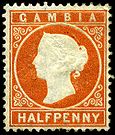
Great Britain
Great Britain or Britain is an island situated to the northwest of Continental Europe. It is the ninth largest island in the world, and the largest European island, as well as the largest of the British Isles...
and France
France
The French Republic , The French Republic , The French Republic , (commonly known as France , is a unitary semi-presidential republic in Western Europe with several overseas territories and islands located on other continents and in the Indian, Pacific, and Atlantic oceans. Metropolitan France...
constantly struggled for political and commercial supremacy in the regions of the Senegal
Sénégal River
The Sénégal River is a long river in West Africa that forms the border between Senegal and Mauritania.The Sénégal's headwaters are the Semefé and Bafing rivers which both originate in Guinea; they form a small part of the Guinean-Malian border before coming together at Bafoulabé in Mali...
and Gambia River
Gambia River
The Gambia River is a major river in West Africa, running from the Fouta Djallon plateau in north Guinea westward through Senegal and The Gambia to the Atlantic Ocean at the city of Banjul...
s. The 1783 Treaty of Paris
Treaty of Paris (1783)
The Treaty of Paris, signed on September 3, 1783, ended the American Revolutionary War between Great Britain on the one hand and the United States of America and its allies on the other. The other combatant nations, France, Spain and the Dutch Republic had separate agreements; for details of...
gave Great Britain
Great Britain
Great Britain or Britain is an island situated to the northwest of Continental Europe. It is the ninth largest island in the world, and the largest European island, as well as the largest of the British Isles...
possession of The Gambia, but the French retained a tiny enclave at Albreda
Albreda
Albreda is a historic settlement in The Gambia on the north bank of the Gambia River, variously described as a 'trading post' or a 'slave fort'. It is located near Jufureh in the North Bank Division and an arch stands on the beach connecting the two places. As of 2008, it has an estimated...
on the north bank of the river, which was ceded to the British in 1857.
As many as 3 million slave
Slavery
Slavery is a system under which people are treated as property to be bought and sold, and are forced to work. Slaves can be held against their will from the time of their capture, purchase or birth, and deprived of the right to leave, to refuse to work, or to demand compensation...
s may have been taken from the region during the three centuries that the transatlantic slave trade operated. It is not known how many slaves were taken by Arab traders prior to and simultaneous with the transatlantic slave trade. Most of those taken were sold to Europeans by other Africa
Africa
Africa is the world's second largest and second most populous continent, after Asia. At about 30.2 million km² including adjacent islands, it covers 6% of the Earth's total surface area and 20.4% of the total land area...
ns; some were prisoners of intertribal wars; some were sold because of unpaid debts, while others were kidnapped. Slaves were initially sent to Europe to work as servants until the market for labor expanded in the West Indies and North America
North America
North America is a continent wholly within the Northern Hemisphere and almost wholly within the Western Hemisphere. It is also considered a northern subcontinent of the Americas...
in the 18th century. In 1807, slave trading was abolished throughout the British Empire, and the British tried unsuccessfully to end the slave trade in The Gambia. They established the military post of Bathurst (now Banjul
Banjul
-Transport:Ferries sail from Banjul to Barra. The city is served by the Banjul International Airport. Banjul is on the Trans–West African Coastal Highway connecting it to Dakar and Bissau, and will eventually provide a paved highway link to 11 other nations of ECOWAS.Banjul International Airport...
) in 1816. In the ensuing years, Banjul was at times under the jurisdiction of the British Governor General in Sierra Leone
Sierra Leone
Sierra Leone , officially the Republic of Sierra Leone, is a country in West Africa. It is bordered by Guinea to the north and east, Liberia to the southeast, and the Atlantic Ocean to the west and southwest. Sierra Leone covers a total area of and has an estimated population between 5.4 and 6.4...
. In 1888, The Gambia became a separate colonial entity.
An 1889 agreement with France established the present boundaries, and The Gambia became a British Crown Colony, divided for administrative purposes into the colony (city of Banjul and the surrounding area) and the protectorate (remainder of the territory).
20th century on
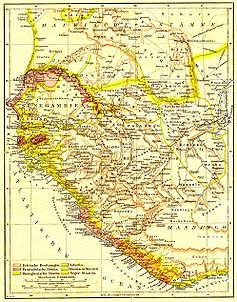
During the Second World War, Gambian troops fought with the Allies
Allies of World War II
The Allies of World War II were the countries that opposed the Axis powers during the Second World War . Former Axis states contributing to the Allied victory are not considered Allied states...
in Burma. Banjul served as an air stop for the U.S. Army Air Corps and a port of call for Allied naval convoys. U.S. President Franklin D. Roosevelt stopped overnight in Banjul en route to and from the Casablanca Conference in 1943, marking the first visit to the African Continent by an American president while in office.
After the Second World War, the pace of constitutional reform increased. Following general elections in 1962, full internal self-governance was granted in the following year. The Gambia achieved independence
Gambia Independence Act 1964
The Gambia Independence Act 1964 was an Act of the Parliament of the United Kingdom that gave independence to the Gambia with effect from 18 February 1965. The Act also provided for the continued right of appeal from the Gambia to the Judicial Committee of the Privy...
on February 18, 1965 as a constitutional monarchy within the Commonwealth
Commonwealth of Nations
The Commonwealth of Nations, normally referred to as the Commonwealth and formerly known as the British Commonwealth, is an intergovernmental organisation of fifty-four independent member states...
. Shortly thereafter, the government held a referendum proposing that an elected president replace the Gambian monarch
Commonwealth Realm
A Commonwealth realm is a sovereign state within the Commonwealth of Nations that has Elizabeth II as its monarch and head of state. The sixteen current realms have a combined land area of 18.8 million km² , and a population of 134 million, of which all, except about two million, live in the six...
as head of state
Head of State
A head of state is the individual that serves as the chief public representative of a monarchy, republic, federation, commonwealth or other kind of state. His or her role generally includes legitimizing the state and exercising the political powers, functions, and duties granted to the head of...
. The referendum failed to receive the two-thirds majority required to amend the constitution, but the results won widespread attention abroad as testimony to The Gambia's observance of secret balloting, honest elections, and civil rights and liberties. On April 24, 1970, The Gambia became a republic within the Commonwealth, following a second referendum, with Prime Minister Sir Dawda Kairaba Jawara, as head of state.
Until a military coup in July 1994, The Gambia was led by President Jawara, who was re-elected five times. The relative stability of the Jawara era was shattered first by a coup attempt in 1981. The coup was led by Kukoi Samba Sanyang
Kukoi Samba Sanyang
Kukoi Samba Sanyang led a 1981 rebellion against the democratically elected Gambian government of President Dawda Jawara.On 31 July 1981, while Jawara was abroad, a 12-member National Revolutionary Council headed by Mr. Sanyang seized control of the country. The leftist NRC accused Jawara's...
, who, on two occasions, had unsuccessfully sought election to Parliament. After a week of violence which left several hundred people dead, Jawara, in London when the attack began, appealed to Senegal
Senegal
Senegal , officially the Republic of Senegal , is a country in western Africa. It owes its name to the Sénégal River that borders it to the east and north...
for help. Senegalese troops defeated the rebel force.
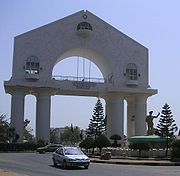
Sénégambia Confederation
Senegambia, officially the Senegambia Confederation, was a loose confederation between the West African countries of Senegal and its neighbour the Gambia, which is almost completely surrounded by Senegal. The confederation came into existence on 1 February 1982 following an agreement between the...
came into existence; it aimed eventually to combine the armed forces of the two states and to unify their economies and currencies. The Gambia withdrew from the confederation in 1989.
In July 1994, Yahya A.J.J. Jammeh led a coup d'état that deposed the Jawara government. Between 1994 and 1996, Jammeh ruled as head of the Armed Forces Provisional Ruling Council
Armed Forces Provisional Ruling Council
Armed Forces Provisional Ruling Council gained control of Gambia in July 1994, in a military coup d'état. The AFPRC deposed the Dawda Jawara government and banned opposition political activity. Lieutenant Yahya A.J.J. Jammeh, chairman of the AFPRC, became head of state...
(AFPRC) and banned opposition political activity. The AFPRC announced a transition plan for a return to democratic civilian rule, establishing the Provisional Independent Electoral Commission (PIEC) in 1996 to conduct national elections. After a constitutional referendum (in August), presidential
Gambian presidential election, 1996
Presidential elections were held in the Gambia on 29 September 1996. The first since Yahya Jammeh's 1994 coup, they were also the first elections to be held under the new constitution, and the first presidential elections to be held alone...
and parliamentary
Gambian parliamentary election, 1997
Parliamentary elections were held in the Gambia on 2 January 1997 three months after presidential elections. The first since Yahya Jammeh's 1994 coup, they were also the first parliamentary elections to be held under the new constitution...
elections were held. Jammeh was sworn into office as president on November 6, 1996. The following year, the PIEC transformed into the Independent Electoral Commission (IEC) on April 17.
Jammeh has won both the 2001
Gambian presidential election, 2001
Presidential elections were held in the Gambia on 18 October 2001. The result was a victory for the incumbent Yahya Jammeh, who took just over 50% of the votes....
and 2006
Gambian presidential election, 2006
The Gambian presidential election, 2006 was held on 22 September 2006. 670,000 Gambians registered to vote, and 59% of registered voters turned out to vote. Many of the 989 polling booths used marbles which were inserted into candidate drums instead of ballot papers due to the high illiteracy rate...
elections. He is up for re-election in 2011
Gambian presidential election, 2011
Presidential elections were held in the Gambia on 24 November 2011. The incumbent Yahya Jammeh faced Ousainou Darboe of the United Democratic Party and Hamat Bah of the National Alliance for Democracy and Development.Voting took place using marbles dropped into coloured bins each containing a...
.
The People's Republic of China
People's Republic of China
China , officially the People's Republic of China , is the most populous country in the world, with over 1.3 billion citizens. Located in East Asia, the country covers approximately 9.6 million square kilometres...
cut ties with The Gambia in 1995 after the latter established diplomatic links with the Republic of China
Republic of China
The Republic of China , commonly known as Taiwan , is a unitary sovereign state located in East Asia. Originally based in mainland China, the Republic of China currently governs the island of Taiwan , which forms over 99% of its current territory, as well as Penghu, Kinmen, Matsu and other minor...
.
The Gambia accepted a non-permanent seat on the UN Security Council from 1998 to 1999.
See also
- History of AfricaHistory of AfricaThe history of Africa begins with the prehistory of Africa and the emergence of Homo sapiens in East Africa, continuing into the present as a patchwork of diverse and politically developing nation states. Agriculture began about 10,000 BCE and metallurgy in about 4000 BCE. The history of early...
- History of West AfricaHistory of West AfricaThe partial history of West Africa can be divided into five major periods:#Its prehistory, in which the first human settlers arrived, agriculture developed, and contact made with the Mediterranean civilizations to the north....
- List of heads of government of the Gambia
- List of heads of state of the Gambia
- Politics of Gambia

